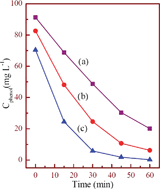Microstructure evolution and advanced performance of Mn3O4 nanomorphologies
Abstract
Mn3O4 morphologies with tetragonal single-crystal

* Corresponding authors
a
School of Environmental and Chemical Engineering, Shanghai University, Shanghai 200444, People's Republic of China
E-mail:
zwchen@shu.edu.cn, gjding@shu.edu.cn
Fax: +86 21 66137787
Tel: +86 21 66137503
b Department of Physics and Materials Science, City University of Hong Kong, Tat Chee Avenue, Kowloon Tong, Hong Kong
c Municipal Water Resource Development and Research Engineering Center (South), Shanghai 200082, People's Republic of China
Mn3O4 morphologies with tetragonal single-crystal

 Please wait while we load your content...
Something went wrong. Try again?
Please wait while we load your content...
Something went wrong. Try again?
C. Chen, G. Ding, D. Zhang, Z. Jiao, M. Wu, C. Shek, C. M. L. Wu, J. K. L. Lai and Z. Chen, Nanoscale, 2012, 4, 2590 DOI: 10.1039/C2NR12079H
To request permission to reproduce material from this article, please go to the Copyright Clearance Center request page.
If you are an author contributing to an RSC publication, you do not need to request permission provided correct acknowledgement is given.
If you are the author of this article, you do not need to request permission to reproduce figures and diagrams provided correct acknowledgement is given. If you want to reproduce the whole article in a third-party publication (excluding your thesis/dissertation for which permission is not required) please go to the Copyright Clearance Center request page.
Read more about how to correctly acknowledge RSC content.
 Fetching data from CrossRef.
Fetching data from CrossRef.
This may take some time to load.
Loading related content
